[vc_row][vc_column width=”2/3″][vc_column_text]The bone is a tissue comprising of collagen and calcium. Collagen which is the protein, responsible for the strength and flexibility of the bone combines with calcium, the hard component of the bone to form a strong yet flexible structure capable of withstanding stress and pressure exerted on it. During the life time of an individual, the bone is continuously being recycled. Matured bones are broken down and replaced by new ones simultaneously. But when the ration of ossification (bone formation) to resorption (bone decomposition) is low, there is a decrease in the mass of bone which causes a disease called osteoporosis.
Osteoporosis is the decrease in bone mass due to high bone resorption. People are more likely to have osteoporosis as they age. According to the Center for Disease Control (CDC), in a 100% population, 10% of women are likely to have Osteoporosis and 2% of men in the same population have Osteoporosis which is a ratio of 1:5. Osteoporosis can affect anyone, but there are some natural factors that are associated with the disease that cannot be reversed as they are linked to the lifespan and background of an individual.
- Age- as an individual ages, chances of osteoporosis also increase. in women, the peak of bone mass is usually 20-30 years. At 30 years, women are likely to start experiencing symptom of osteoporosis such as lower, hip fracture etc. these symptoms are not necessary osteoporosis but in most cases are related to the disease. Osteoporosis in older women starts at 50years and above while in men, they may experience osteoporosis starting at 70years and above as well.
- Race and body size-osteoporosis is mostly common among white/Asian women (mayo clinic). More white and Asian women have less body/ bone mass and are more prone to osteoporosis.
-
- Genetic traits- Osteoporosis might run in the family. For people whose biological family members have recently suffered a hip fracture and is diagnosed with osteoporosis should check with the doctor because it could be genetic and their chances of suffering from osteoporosis are increased.
- Sex- Osteoporosis is more common in women than in men. Women experience a decrease in their estrogen levels at an earlier age than men, as they age and that increases their chances of having osteoporosis as well.
Other reversible factors may also lead to osteoporosis. These factors include:
- Prolonged use of medications for chronic illnesses in elderly people may impede the absorption of calcium according to the National Institute for heals for Health. Aluminum- containing medications also decrease the composition of bone if consumed for a long time (NIH).
- Malnutrition or poor diet -people whose diet has less calcium would have lesser bone mass and their chance of osteoporosis is great. Malnutrition might also be as a result of Anorexia, Gastrointestinal surgeries which is decreasing the size of the intestinal organs, can reduce the absorption of calcium into the blood stream.
- Lack of weight-bearing exercise- people who perform less weight-bearing exercise are at a higher risk of getting osteoporosis. Exercise increases the density of bones is also decreases the chances of osteoporosis. People who perform less or no exercise are very prone to the disease.
Symptoms such as chronic back pain, a sudden decrease in height, hip fractures and vertebra injuries are sign related with osteoporosis, although it might not necessary be the disease. Anyone experiencing these symptoms needs to consult with the doctor immediately.
Call Us Now
Get the Best CPR Class in Tampa Today!
Prevention and control of Osteoporosis
Osteoporosis is a disease does not have a precise treatment but there are strategies used to lower the rate of bone loss and prevent the disease and other common symptoms associated with it.
- Calcium makes two-third of bones and is a very vital component of the body. Consuming the right proportion of calcium will increase bone density and hardness. A normal diet should contain at least 1000mg of calcium per day. Calcium supplements are also a good source of calcium for people who have low calcium absorption through food.
- Exercise is a second necessary routine that helps increase bone mass. Exercises such as weight-lifting, soccer, basketball, running and biking are good for not only increasing the size of bone but also helping you maintain a healthy lifestyle. Exercising at least 30 minutes a day is a great way to strengthen your bones.
- Vitamin D is essential for calcium absorption in the body. A very good source of vitamin D besides milk and other foods is sunlight. Early morning sunlight is warm and a good source of vitamin D. But too much exposure to sunlight can cause skin cancer.
- Avoid clutter in the home which may cause you to trip and fall especially in adult as they are likely to get hurt. Take precaution when climbing the stairs as well.
Reference
“Disease and Conditions: Osteoporosis.” Mayo Clinic. Mayor Clinic Staff, 13 Dec. 2014. Web. 17 Mar. 2015. <http://www.mayoclinic.org/diseases-conditions/osteoporosis/basics/definition/con-20019924>.
“Genomics, Family History & Osteoporosis.” Centers for Disease Control and Prevention. Centers for Disease Control and Prevention, 19 May 2014. Web. 17 Mar. 2015. <http://www.cdc.gov/features/osteoporosis/>.
Office of Public Health Genomics. CDC, 19 May 2014. Web. 17 Mar. 2015.
“Osteoporosis.” – NIH Osteoporosis and Related Bone Diseases National Resource Center. National Institute of Health, n.d. Web. 17 Mar. 2015. <http://www.niams.nih.gov/Health_Info/Bone/SGR/surgeon_generals_report.asp>.
“Osteoporosis.” Centers for Disease Control and Prevention. Centers for Disease Control and Prevention, 27 Feb. 2015. Web. 18 Mar. 2015. <http://www.cdc.gov/nchs/fastats/osteoporosis.htm>.
[/vc_column_text][/vc_column][vc_column width=”1/3″][vc_single_image image=”9789″ img_size=”medium” alignment=”center”][vc_single_image image=”6623″ img_size=”medium” alignment=”center”][vc_single_image image=”6538″ img_size=”medium” alignment=”center”][vc_single_image image=”6621″ img_size=”large” alignment=”center”][vc_single_image image=”6625″ img_size=”large” alignment=”center”][vc_single_image image=”6626″ img_size=”medium” alignment=”center”][vc_single_image image=”6523″ img_size=”medium” alignment=”center” onclick=”custom_link” link=”https://cprtampa.training/cpr-tampa-class-reviews-tampa-florida/”][vc_single_image image=”6655″ img_size=”medium” alignment=”center”][/vc_column][/vc_row]


